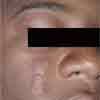Herpes Zoster (Shingles) in a Teenager
Sixteen-year-old with a recurrent, painful, pruritic rash on right cheek and right eyelid. Current outbreak started 2 days earlier. The rash always appears in the same fashion and in the same location; it typically lasts a few days and resolves spontaneously.

HISTORY
Sixteen-year-old with a recurrent, painful, pruritic rash on right cheek and right eyelid. Current outbreak started 2 days earlier. The rash always appears in the same fashion and in the same location; it typically lasts a few days and resolves spontaneously.
No eye pain or discomfort. No prodromal symptoms (eg, tingling, numbness, or pain) before rash onset. Patient believes that rash is related to being outdoors during the warm months. Complains of feeling feverish.
Patient has eczema and asthma and had chickenpox when he was 6 years old.
PHYSICAL EXAMINATION
Well-appearing afebrile adolescent in no apparent distress. The only positive physical finding: a 3 3 1-cm area of multiple, coalescing vesicles on the right cheek tender to palpation. A second area with 5 to 6 vesicles present over the right upper eyelid.
The diagnosis, based on the history and clinical presentation, was reactivated herpes zoster (shingles).
Herpes zoster is the reactivation of the varicella virus (chickenpox). It appears as painful crops of cutaneous vesicles that are distributed along specific dermatomes that correspond to the dorsal root ganglia where the virus is latent (between recurrences). The causative agent is the human herpesvirus 3 (HH3), which occurs worldwide. HH3 can cause both the primary form of varicella (chickenpox) and the reactivated form (shingles).
The incidence and complications of both varicella and zoster are much higher in immunocompromised patients.1 The incidenceof herpes zoster also increases with age. Herpes zoster is relatively rare in children, but the earlier primary varicella develops, the greater is the likelihood that herpes zoster will develop in childhood or early adulthood.2
WHAT'S YOUR DIAGNOSIS?
CLINICAL MANIFESTATIONS
Typically, a prodromal or pre-eruptive phase is noted before the eruption of vesicles. In the prodromal phase, cutaneous symptoms include paresthesias, pain, and tingling, which may last up to 72 hours. Following this phase, vesicles erupt in a dermatomal fashion and undergo stages of vesicular rupture, crusting, and possible scarring. The last phase is resolution, but reactivation can occur at any time.
Sequelae of herpes zoster include herpes ophthalmicus, CNS complications, and otic zoster (Ramsay Hunt syndrome).
TREATMENT
Management of zoster in children is controversial.3 Zoster lesions contain the HH3 virus; viral shedding and spread to susceptible hosts (pregnant patients, immunocompromised patients) is therefore possible. Transmission can result in either primary disseminated varicella or reactivation dermatomal zoster. Consequently, patients with zoster need to be isolated from susceptible persons.
The need for post-exposure prophylaxis depends on the setting. The American Academy of Pediatrics (AAP) recommends administration of varicella immu- noglobulin (VZIG) within 96 hours of exposure in a patient who is at risk for developing the disease and its complications.
Treatment depends on a patient's immune status. The AAP currently does not recommend the routine use of antivirals such as acyclovir in an otherwise healthy, immunocompetent person who does not have a complicated form of the disease.3 The AAP also suggests that patients with a history of eczema, who may be prone to secondary bacterial infection, may benefit from oral acyclovir if given early in the course of the illness.4 One reason for this recommendation is that disseminated zoster infection (eczema herpeticum) may develop in patients with underlying eczema and in those who are immunocompromised.
Antiviral agents decrease viral shedding but do not affect the resolution of symptoms such as neuralgia. Corticosteroids are not of proven benefit.
Common complications of herpes zoster include secondary bacterial infections, depigmentation of the affected area, and scarring.2 Herpes zoster ophthalmicus is a serious ocular form of zoster infection and is characterized by serpiginous (dendritic) corneal ulcers. These ulcers may become chronic and result in loss of vision. Optic keratitis and uveitis are among the more chronic complications of zoster infection. Oral acyclovir treatment is thought to be of some value in patients with ocular herpes zoster.5
References:
REFERENCES:
1.
Arvin AM. Varicella-zoster virus.
Clin Microbiol Rev.
1996;9:361-381.
2.
Leung AK, Rafaat M. Photo quiz. Vesicular rash on the flank and buttock.
Am Fam Physician.
2003;67:1045-1046.
3.
American Academy of Pediatrics. Varicella-zoster infections. In: Pickering LK, ed.
Red Book: 2003 Report of the Committee on Infectious Diseases.
26th ed. Elk Grove Village, Ill: American Academy of Pediatrics; 2003:672-686.
4.
Lancaster T, Silagy C, Gray S. Primary care management of acute herpes zoster: systematic review of evidence from randomized controlled trials.
Br J Gen Pract.
1995;45:39-45.
5.
Stankus SJ, Dlugopolski M, Packer D. Management of herpes zoster (shingles) and postherpetic neuralgia.
Am Fam Physician.
2000;61:2437-2444, 2447-2448.
Recognize & Refer: Hemangiomas in pediatrics
July 17th 2019Contemporary Pediatrics sits down exclusively with Sheila Fallon Friedlander, MD, a professor dermatology and pediatrics, to discuss the one key condition for which she believes community pediatricians should be especially aware-hemangiomas.